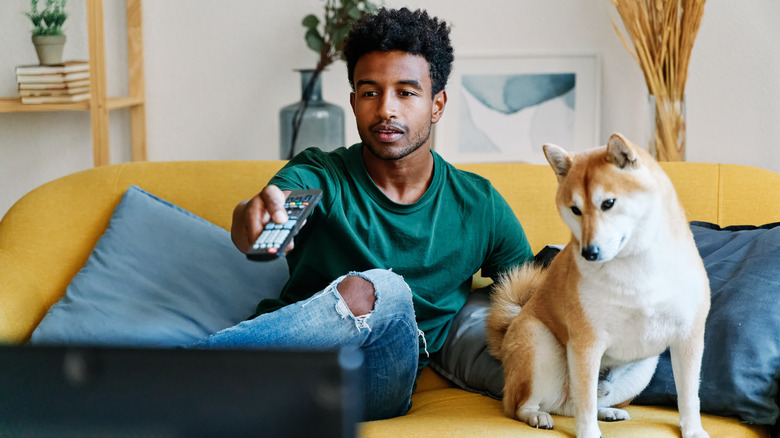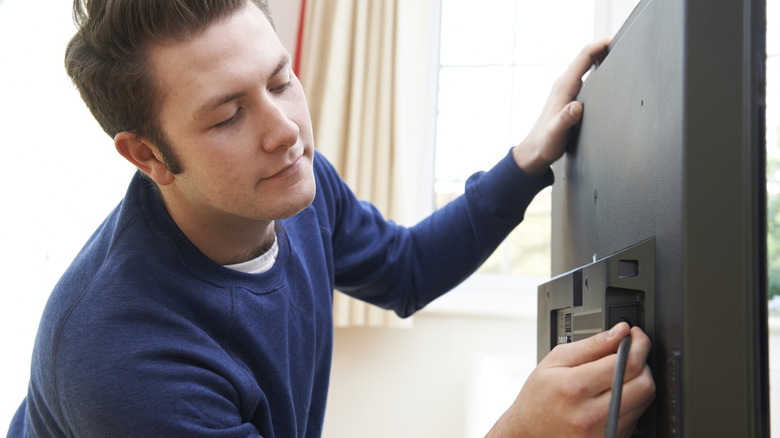Audio Delay On TV: Possible Causes And Fixes To Try
At some point in your TV viewing life, you've probably experienced a television with an audio delay. You'll know this is happening when the movement of an actor's lips doesn't quite match up with the audio of them speaking or the sound effects lag behind the on-screen action. While this common problem won't keep you from watching programs on your TV, it's a big distraction and takes away from the viewing experience.
Even top-rated smart TVs can experience these issues from time to time. However, it's important to keep in mind that audio delay problems don't always originate with the TV itself. Sometimes, it might be a streaming app causing the issue; at other times, there may be problems with your internet connection. Whatever the case may be, you'll want to figure out what's going on as quickly as possible so you can get back to watching your show as it was meant to be enjoyed — with the spoken word and on-screen action synching with the audio.
What causes TV audio delay?
Sometimes, your TV has nothing to do with the audio delays you're experiencing. Instead, your local broadcast station could be responsible, depending on the signal it's broadcasting. This happens when there's a small difference between how fast the audio and video signals are processed and affects all programming. Most times, you won't even be able to notice the difference, but sometimes you will.
If your local broadcaster isn't causing your audio delay issue, outdated software or firmware might be responsible for the problem. When you get a smart TV, you probably spend time learning about all of its useful settings so you can get the most out of it. If you're experiencing an audio delay, it might be because your TV's software isn't up to date, causing it to struggle to process audio and video signals correctly or causing lag. TV manufacturers often release patches to fix these issues, so it's important to keep your TV's software up to date.
Incorrect audio settings can also cause audio delays. If you buy a soundbar to complement your new smart TV and don't configure it correctly, you might experience sound that's out of sync. Defective or damaged HDMI or other audio cables or cables that aren't connected properly can also cause problems by disrupting the signal transmission. If you experience trouble while streaming, a poor internet connection could be to blame. Not having enough bandwidth and unstable connections can both lead to buffering and synchronization issues.
Fixes to try to resolve audio delay
Once you've confirmed the audio delay you're experiencing isn't caused by your local broadcast station, it's time to look at other possible sources for the problem. You can start by changing your TV's sound settings to PCM stereo to see if that fixes the problem. Also, check your TV settings menu to see if it has a slider bar to increase or decrease digital output. You might need to adjust this a few times to fix the issue.
If that doesn't fix the problem, check to see if your TV's firmware is up to date. You can find this information in the settings on most TVs. If you don't have the latest firmware version, you should update it to see if that resolves the problem. Check the manufacturer's website or user's manual for specific instructions on how to do this. As mentioned earlier, faulty cables can cause audio delays. If you suspect this is the problem, inspect your HDMI or optical cables for any visible damage and make sure they're connected securely to your TV. If you find the cables are damaged, you should replace them to ensure a stable connection.
Sometimes, the streaming app you're using is the culprit when it comes to audio delay issues. Apps like YouTube TV, Prime Video, Netflix, and Disney Plus are all known to experience audio sync issues occasionally. If you're having problems with these apps, check the settings for any audio synchronization options. If you keep having trouble, consider restarting and reinstalling the app or contacting support for help.


